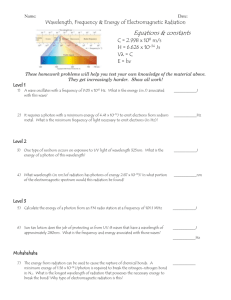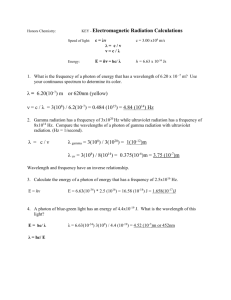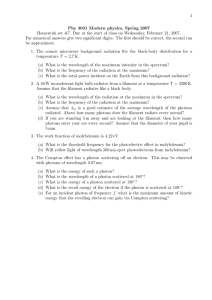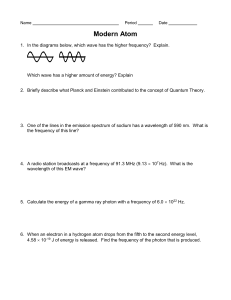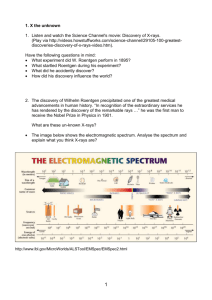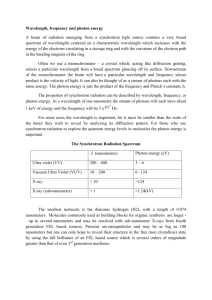Photons 6.1 Quantum Physics. Particle Nature of Light
advertisement
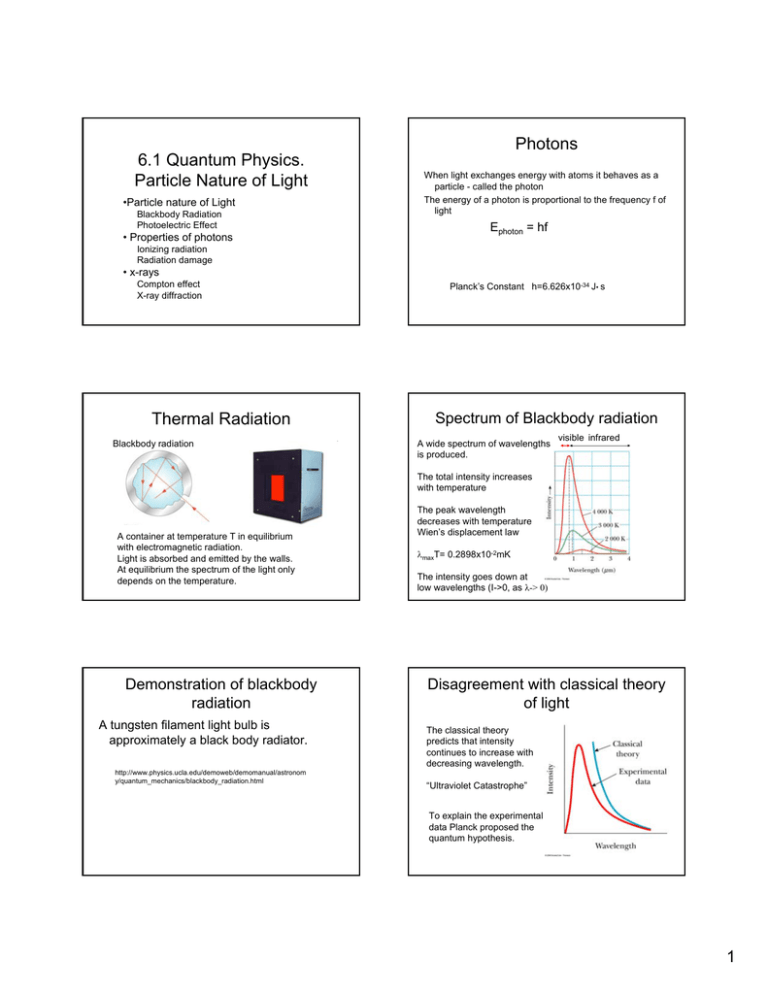
6.1 Quantum Physics. Particle Nature of Light •Particle nature of Light Blackbody Radiation Photoelectric Effect • Properties of photons Photons When light exchanges energy with atoms it behaves as a particle - called the photon The energy of a photon is proportional to the frequency f of light Ephoton = hf Ionizing radiation Radiation damage • x-rays Compton effect X-ray diffraction Thermal Radiation Blackbody radiation Planck’s Constant h=6.626x10-34 J• s Spectrum of Blackbody radiation A wide spectrum of wavelengths is produced. visible infrared The total intensity increases with temperature A container at temperature T in equilibrium with electromagnetic radiation. Light is absorbed and emitted by the walls. At equilibrium the spectrum of the light only depends on the temperature. Demonstration of blackbody radiation A tungsten filament light bulb is approximately a black body radiator. http://www.physics.ucla.edu/demoweb/demomanual/astronom y/quantum_mechanics/blackbody_radiation.html The peak wavelength decreases with temperature Wien’s displacement law λmaxT= 0.2898x10-2mK The intensity goes down at low wavelengths (I->0, as λ-> 0) Disagreement with classical theory of light The classical theory predicts that intensity continues to increase with decreasing wavelength. “Ultraviolet Catastrophe” To explain the experimental data Planck proposed the quantum hypothesis. 1 Planck’s constant Classical and Planck picture Suppose we have a box that contains light waves with different wavelengths. The energy is contained in energy states containing particles with different energies Planck proposed that light could only have certain energies E=hf Then the energy of oscillators in the black body could only have certain fixed values Classical theory predicts that the number of energy states (like standing waves) increased with decreasing wavelength. Planck proposed that in addition the short wavelength particles are more “energetically expensive” Max Planck So at short wavelength, they would be hard to produce. This explains the peak in the black body spectrum Quantum explanation for the Wein Effect. sun The sun has a surface temperature of 5,800 K. The solar radiation has a peak wavelength of 500 nm. The earth has temperature of about 300 K. What is the maximum wavelength of the blackbody spectrum of the earth? •The blackbody spectrum reflects the distribution of photon energies. •The peak wavelength reflects the average energy. •The average photon energy increases linearly with temperature from λ T = cons tan t Wein Law max since λ= then T ∝ c f 1 λmax Question earth λmax T = cons tan t earth earth sun sun λmax T = λmax T hf ∝ max ∝ Average c photon energy The “Greenhouse Effect” is based on properties of blackbody radiation earth λmax = λ sun sun max earth T T = 500x10 −9 m(5800K) = 9.7x10 −6 m 300K 10micrometers infrared region CO2 and Global Warming sun T~6000K visible Infrared Atmosphere is transparent to light from sun earth T~ 300 K Atmosphere absorbs infrared radiation and serves as a “blanket”. Graph showing that the observed temperature rise can easily result from the observed rise of CO2 , based on simple numerical experiment. (Smoothed temperature data in Jones et al., 1998; CO2 forcing data from CO2 history, and calculated expected rise in temperature assuming 2 degree Celsius rise for CO2 doubling; sunspot abundance from J.Lean, NASA) http://earthguide.ucsd.edu/globalchange/global_warming/03.html 2 Sources of visible light Tungsten Lamp light source blackbody spectrum incandescent lamp hf black body radiation of a heated metal filament hf e- fluorescent bulb emission of excited atoms Hg hf semiconductor Visible light light emitting diode emission by electron across an energy gap in a semiconductor Fluorescent bulbs and LEDs are more efficient sources of light than incandescent lamps. Light emitting diode LED A tungsten lamp is inefficient as a light source because the spectrum at temperatures lower than the melting point includes a large amount of useless infrared radiation. Photoelectric effect. Electrode - λ Light emitting diodes are more efficient as an illumination source because the spectrum is not based on blackbody radiation. The light can be produced at specific wavelengths in the visible region Photoelectric effect A current is observed when light of certain wavelengths hits the electrode I - + Photoelectric Effect (e∆Vs) e∆Vs = KEmax 0 The stopping voltage ∆Vs is a measure of the kinetic energy of the photo electrons. When the ∆Vs is high enough electrons don’t reach the electrode C. Kinetic energy rises linearly with the frequency of light. 3 Einstein’s explanation Photon concept photon energy =hf Ephoton =hf e- Slope =h 0 “Energy loss” φ KEmax = Ephoton -φ = hf- φ A photon interacts with the electron The light energy can have only specific values. Light energy is quantized φ is the work function, the energy needed to remove the electron from the electrode. Photon Energy Properties of Photons Find the energy of a photon with a wavelength of 500 nm. Use units of electron volts (1eV= 1.60x10-19 J) Photon energies - Interactions of light with matter. E = hf = h Ionizing radiation Radiation damage E= x-rays Compton effect X-ray diffraction An electron volt is the energy change in moving an electron across a potential of 1 volt. A few electron volts is the energy of electrons in molecules. This is why visible light is absorbed by molecules (pigment molecules). Photon concept E=hf =hc/λ 10-6 10-3 1 absorber source 103 106 eV Ephoton =hf ∆E=hf ir ⎛ 3x108 m / s ⎞ c −19 = 6.63x10 −34 Js ⎜ ⎟ = 4.0x10 J −9 ⎝ 500x10 m ⎠ λ 4x10 −19 J = 2.5eV 1.6x10 −19 J / eV Photon Energies (eV) 10-9 metal electrode KEmax = hf - φ uv ∆E=hf Light energy is has specific energies i.e. is quantized in the interaction of light with matter. Photons of different wavelengths, interact with different molecular properties- either in the generation of the photon or the absorption of the photon. 4 Photon Energies light Typical Wavelength (m) Typical Molecular Photon energy interactions (eV) applications radio 10 10-7 eV nuclear magnetic NMR imaging microwaves 10-2 10-4 eV Molecular rotations Microwave oven cell phone Infrared 10-5 10-1 eV Molecular vibrations Heat lamp Visible 400-700 nm 2-3 eV Low energy electrons (pigments) Vision Photosynthesis Photography Ultraviolet 200-300 nm 4-5 eV bonding electrons Radiation damage Skin cancer X-rays 1 nm 104 eV Electrons scattering, tightly bound electrons X-ray imaging X-ray diffraction Microwave Oven f =10GHz hf =4x10-5 eV Heats by exciting molecular rotations and vibrations. Cell phones use the same frequency range but at much lower intensity. UV light damage to inkjet prints • Infrared light absorbed by vibrations of gas molecules • Visible light absorbed by electronic transitions in pigment • UV radiation – 4-5 eV photons cause radiation damage by altering DNA (UV-B radiation at 320-290 nm) • Ozone in the atmosphere protects by absorbing UV radiation. Radiation damage to DNA UV light treated Uv protected Biological effects of uv radiation UV light Altered DNA Organisms living in shallow sea water are susceptible to increased uv radiation. 5 Generation of x-rays by electrons X-rays X-rays are produced by electrons accelerated through high voltages V~ 104 V Photon energies ~ 104 eV X-rays X-rays e- Rotating anode A Quantum Effect. The maximum photon energy is ~ equal to the kinetic energy of the electron. e∆V = hfmax = hc λmin X-ray source X-ray spectrum produced by 35 keV electrons hitting a molybdenum target. x-ray imaging Question Find the minimum x-ray wavelength for a 35 kev electron. e- KE E=hf photon hf=KE (neglect work functionit is small compared to x-ray energies) KE= 35x103 eV x (1.6x10-19 J/eV) = 5.6x10-15J Emax = hfmax = λmin = λmin hc = KE λmin x-ray photograph of Wolfgang Roentgen’s wife’s hand. x-rays penetrate soft tissue (light atoms) but are absorbed by heavy metal atoms. eg.Calcium, Gold hc 6.63x10−34 Js(3.0x108 m / s) = = 3.6x10 −11m 5.6x10−15 J KE 0.036 nm 6 Compton scattering of x-rays. High energy photons knock electrons out of atoms The wavelength of a photon scattered from an electron is increased due to loss of photon energy. Incident photon λo electron h ∆λ = λ − λ o = (1 − cos θ) me c Scattered electron ө λ Scattered photon X-ray diffraction • X-rays have wavelengths close to atomic dimensions • Crystalline solids have an ordered array of atoms that scatter x-rays much like a three-dimensional diffraction grating • The x-ray diffraction pattern from crystals of molecules can be used to determine the density of scattering electrons (i.e. the electron density) and thus the molecular structure. Lower energy –> Longer wavelength NaCl Crystal – an ordered array of atoms 0.56 n Diffraction of x-rays from a crystal. Each atom acts as a wave source. Fig. 27-11, p.883 X-ray diffraction pattern of NaCl Condition for diffraction of x-rays from planes of atoms in a crystal Bragg’s Law 2dsinө = mλ m=1, 2, 3 ........ 7 DNA structure determined by x-ray diffraction X-ray diffraction pattern from a crystalline fiber of DNA. Watson And Crick used this data to deduce the structure of the DNA molecule 8
